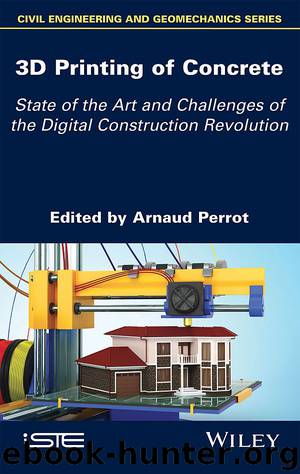3D Printing of Concrete by Arnaud Perrot

Author:Arnaud Perrot
Language: eng
Format: epub
ISBN: 9781119610786
Publisher: Wiley
Published: 2019-04-15T00:00:00+00:00
3
3D Printing by Selective Binding in a Particle Bed: Principles and Challenges
3.1. Introduction
Within the area of additive manufacturing of cement-based materials for the construction of elements or structures, two different techniques are used: processes based on the extrusion of fresh concrete, and the deposition of ink into layered aggregates or a powder/aggregates mixture. The ink is made up of water and additives, cement materials and/or organic materials, depending on the chosen process. These processes are commonly referred to as 3D selective binding methods for printing.
According to Claude Barlier and Alain Bernard [BAR 16], the binding of fine layers of powder using an injection of ink was patented in 1993 by Sachs [SAC 93]. Among the seven families of additive manufacturing listed in the standard ISO 17296-2, the family consisting of the projection of a binder onto a substrate, developed at MIT, is often used outside the field of civil engineering for the creation of bone implants, models for molding and various objects for art and decoration. The first part, made from concrete by selective bonding, dates back to 1995 and uses a technique in which the cement is activated by water vapor [PEG 95, PEG 97].
The principle of the technique known as additive manufacturing by selective activation is simple: a fluid material is deposited by the nozzle of a 3D printer, which then penetrates into a bed of particles to bond them together. These steps are then repeated layer-by-layer until a 3D structure that has been modeled is obtained. To do this, the dry material and the ink are moved independently at each stage, which differentiates this technique from simple concrete extrusion.
The supply system for the dry material often consists of a container placed next to the piece to be constructed. A system for leveling the particle bed can also be used to consolidate or even compact the particle bed, depending on the ink used. The final step consists of removing the solid particles that are not bonded, which can be reused to produce other parts.
The challenges of carrying out this technique more effectively in the field of civil engineering involve the choice of particular properties in terms of aggregates, mineral binder, aqueous solutions or polymers used as the binding paste/ink with regard to the need for precision, quality and fineness of the surface, the manufacturing time, and operations to be done after the production is complete. On the contrary, these techniques do not require a complete redefinition of the digital design process used in conventional additive manufacturing by the successive creation of 2D layers. The steps for creating a 3D CAD model, meshing in the STL format, and the process for the cross-sectioning and production by layers are thus suitable for production by selective bonding. Nevertheless, it is necessary to use two distinct methods for depositing the ink and powdered materials, compared with a simple extrusion.
Overcoming the scientific obstacles to the development of a reliable method of selective manufacturing in the construction sector is an important challenge in terms of technology and economics.
Download
This site does not store any files on its server. We only index and link to content provided by other sites. Please contact the content providers to delete copyright contents if any and email us, we'll remove relevant links or contents immediately.
Sass and Compass in Action by Wynn Netherland Nathan Weizenbaum Chris Eppstein Brandon Mathis(7915)
Autodesk Civil 3D 2024 from Start to Finish by Stephen Walz Tony Sabat(7124)
Mathematics for Game Programming and Computer Graphics by Penny de Byl(7045)
Taking Blender to the Next Level by Ruan Lotter(6838)
Express Your Creativity with Adobe Express by Rosie Sue(6642)
Hands-On Unity 2022 Game Development - Third Edition by Nicolas Alejandro Borromeo(6250)
Hands-On Unity 2022 Game Development by Nicolas Alejandro Borromeo(5070)
Unreal Engine 5 Character Creation, Animation, and Cinematics by Henk Venter & Wilhelm Ogterop(3962)
Going the Distance with Babylon.js by Josh Elster(3923)
Squeaky Clean Topology in Blender by Michael Steppig(3805)
Mastering Graphics Programming with Vulkan by Marco Castorina & Gabriel Sassone(3803)
Adobe Illustrator for Creative Professionals by Clint Balsar(3737)
Drawing Shortcuts: Developing Quick Drawing Skills Using Today's Technology by Leggitt Jim(2960)
Unreal Engine 5 Character Creation, Animation, and Cinematics by Henk Venter Wilhelm Ogterop(2909)
Rapid Viz: A New Method for the Rapid Visualization of Ideas by Kurt Hanks & Larry Belliston(2793)
The 46 Rules of Genius: An Innovator's Guide to Creativity (Voices That Matter) by Marty Neumeier(2723)
Learn Qt 5: Build modern, responsive cross-platform desktop applications with Qt, C++, and QML by Nicholas Sherriff(2396)
Fusion 360 for Makers by Lydia Sloan Cline(2262)
Hands-On Neural Networks with Keras by Niloy Purkait(2209)
